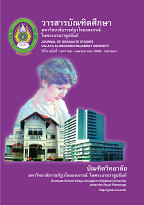การวิเคราะห์สมรรถนะของครูไทยตามกรอบสมรรถนะของครูแห่งเอเชียตะวันออกเฉียงใต้ในศตวรรษที่ 21 : กรณีศึกษาเขตพื้นที่ภาคกลาง
Main Article Content
Abstract
บทคัดย่อ
การวิจัยนี้มีวัตถุประสงค์ 1) เพื่อวิเคราะห์ระดับสมรรถนะของครูไทยตามกรอบสมรรถนะของครูแห่งเอเชียตะวันออกเฉียงใต้ในศตวรรษที่ 21 และ 2) เพื่อเปรียบเทียบสมรรถนะของครูไทยตามกรอบสมรรถนะของครูแห่งเอเชียตะวันออกเฉียงใต้ในศตวรรษที่ 21 จำแนกตามขนาดของสถานศึกษา กลุ่มตัวอย่าง คือ ครูสังกัดสำนักงานคณะกรรมการการศึกษาขั้นพื้นฐาน จำนวน 375 คน โดยใช้วิธีการสุ่มแบบหลายขั้นตอน เครื่องมือที่ใช้ในการวิจัยครั้งนี้เป็นแบบสอบถามเกี่ยวกับสมรรถนะครูไทยตามกรอบสมรรถนะของครูแห่งเอเชียตะวันออกเฉียงใต้ในศตวรรษที่ 21 จำนวน 1 ชุด มีค่าดัชนีความสอดคล้องของข้อคำถาม (IOC) อยู่ระหว่าง 0.8 – 1.0 และความเที่ยงแบบสัมประสิทธิแอลฟาของครอนบาก เท่ากับ .97 วิเคราะห์ข้อมูลโดยใช้สถิติเชิงบรรยาย ได้แก่ ค่าความถี่ ร้อยละ ค่าเฉลี่ยเลขคณิต ส่วนเบี่ยงเบนมาตรฐาน ความเบ้ ความโด่ง และใช้สถิติเชิงอ้างอิง ได้แก่ F-test ด้วยการวิเคราะห์ความแปรปรวนทางเดียว อีกทั้งวิเคราะห์ข้อมูลเชิงคุณภาพด้วยการวิเคราะห์เนื้อหา ผลการวิจัยสรุปได้ ดังนี้
1. ครูไทยมีสมรรถนะตามกรอบสมรรถนะของครูแห่งเอเชียตะวันออกเฉียงใต้ในศตวรรษที่ 21 โดยภาพรวมและรายด้านทั้ง 11 ด้าน อยู่ในระดับค่อนข้างสูง โดยสมรรถนะด้านการส่งเสริมค่านิยมด้านศีลธรรมและจริยธรรมมีค่าเฉลี่ยสูงสุด รองลงมา ได้แก่ ด้านการสร้างสภาพแวดล้อมการเรียนรู้ และด้านการจัดสวัสดิการแก่นักเรียน ตามลำดับ ส่วนด้านการสร้างเครือข่ายกับผู้เกี่ยวข้องโดยเฉพาะผู้ปกครอง พบว่า มีค่าเฉลี่ยน้อยที่สุด
2. ผลการเปรียบเทียบค่าเฉลี่ยสมรรถนะของครูไทยตามกรอบสมรรถนะของครูแห่งเอเชียตะวันออกเฉียงใต้ในศตวรรษที่ 21 จำแนกตามขนาดโรงเรียน (ใหญ่ กลาง และเล็ก) โดยการวิเคราะห์ความแปรปรวนทางเดียว พบว่า ภาพรวมและรายด้านทั้ง 11 ด้าน ไม่มีความแตกต่างกันอย่างมีนัยสำคัญทางสถิติที่ระดับ .05
3. ผลการวิเคราะห์ข้อเสนอแนะในการพัฒนาสมรรถนะครูไทย พบว่า มีประเด็นสำคัญเรียงตามลำดับความสำคัญ 5 ประเด็นหลัก ได้แก่ 1) ด้านการวิจัยในชั้นเรียน 2) ด้านการวัดประเมินผลการเรียนรู้ 3) ด้านการจัดการเรียนการสอน 4) ด้านการใช้สื่ออุปกรณ์ 5) ด้านการมีส่วนร่วมกับชุมชน
ABSTRACT
The purposes of this research were 1) to analyze the Thai teacher’s competency according to the Southeast Asian teacher’s competency framework in the 21st Century: A Case Study of the Central Region and 2) to compare the Thai teacher’s competency according to the Southeast Asian teacher’s competency framework in the 21st Century by the size of the school. The samples were 375 teachers of schools under the jurisdiction of the Office of Basic Education Commission. The research instrument was a 5-point scale with Index of Item - objective of congruence: IOC between 0.8 – 1.0 and Cronbach’s alpha reliability of .97. The data were analyzed descriptively and inferentially including frequency, percentage, mean, standard deviation, skewness, kurtosis and F-test for ANOVA, and the qualitative data were analyzed by content analysis. The research findings were as follows:
1. Thai teacher’s competency according to the Southeast Asian teacher’s competency framework in the 21st Century, both overall and in the 11 aspects were at a relatively high level. When considering each aspect, the priority of competency from highest to lowest was the promotion of moral and ethical values, the creation of a learning environment, and the welfare of the students respectively while the mean in creating a network with stakeholders, particularly parents of students was the lowest average.
2. The comparison of Thai teacher’s competency according to the Southeast Asian teacher’s competency framework in the 21st Century by one - way ANOVA showed that overall and in all 11 aspects, there was no statistically significant difference between the three school sizes (large, medium and small) at the .05 level.
3. Suggestions on the development of teacher’s competencies found that there are 5 main issues in order of importance which were: 1) classroom action research 2) learning assessment 3) Instruction management 4) materials using, and 5) community participation.
Article Details

This work is licensed under a Creative Commons Attribution-NonCommercial-NoDerivatives 4.0 International License.
บทความทุกเรื่องได้รับการตรวจความถูกต้องทางวิชาการโดยผู้ทรงคุณวุฒิ ทรรศนะและข้อคิดเห็นในบทความ Journal of Global of Perspectives in Humanities and Social Sciences (J-GPHSS) มิใช่เป็นทรรศนะและความคิดของผู้จัดทำจึงมิใช่ความรับผิดชอบของบัณฑิตวิทยาลัย มหาวิทยาลัยราชภัฏวไลยอลงกรณ์ ในพระบรมราชูปถัมภ์ กองบรรณาธิการไม่สงวนสิทธิ์การคัดลอก แต่ให้อ้างอิงแหล่งที่มา


